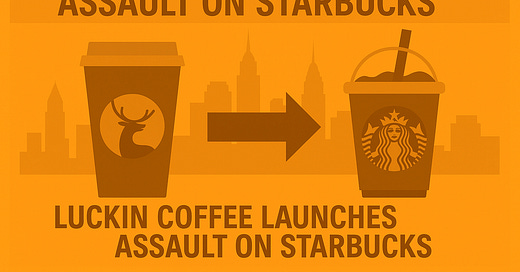Chinese coffee giant Luckin launches major attack on Starbucks
With aggressive prices and innovative drinks, Luckin Coffee is now attacking Starbucks on its home market and bringing its successful model directly to New York City.
The Chinese coffee giant Luckin is launching its major attack on Starbucks with two new stores in New York City. This market entry not only grabs the attention of the US coffee industry, but also signals the start of an ambitious expansion. While Starbucks is coming under pressure in its home market, Luckin is bringing a model to America that has already led to success in China. To grasp the implications of this move, it is worth looking back at the rapid rise of a company that once faltered and is now attacking harder than ever.
Generated by AI (DALE-E3)
From scandal to market leader: Luckin's model for success
With over 24,000 stores, the company surpasses Starbucks in terms of locations and sales. In 2023, Luckin achieved an annual turnover of 24.9 billion yuan (approx. 3.24 billion euros), overtaking Starbucks' revenue of around 3.16 billion dollars (approx. 2.94 billion euros). The road there was bumpy: in 2020, the company was rocked by an accounting scandal when false sales figures were revealed. This led to a fine of 180 million dollars (approx. 167.4 million euros), the resignation of the founder and deregistration from the Nasdaq. A reorganization under new management stabilized the business.
Its success is based on a model that prioritizes speed and low prices. Luckin branches are often compact pick-up stations equipped with fully automatic coffee machines. A waiter fills inexpensive drinks into paper cups, ideal for a quick coffee on the way to the office. Prices are up to 30 percent lower than Starbucks. Fruity creations such as pineapple cold brews or coconut lattes appeal to young, mobile customers who order via an app and value trendy, affordable options.
Starbucks focuses on experience instead of efficiency
Starbucks is pursuing a contrasting approach. The chain is establishing itself as a "third place" - a space between home and work that invites people to linger. Branches offer cozy seating areas, subdued lighting and an atmosphere that allows you to chat with friends or read a newspaper in peace. The coffee is expensive, often overpriced, but customers pay for the environment: clean rooms, relative silence and a feeling of comfort. This concept culminates in the Starbucks Roastery in Shanghai, the largest branch in the world. There, baristas roast the coffee on site and celebrate the preparation as an art form, creating an experience that goes far beyond buying a drink. While Luckin focuses on efficiency, Starbucks offers a stage for social and personal moments.
The target groups are clearly different. Luckin appeals to young, urban Chinese who want fast, affordable and innovative drinks, often ordered by app. Starbucks attracts customers who are looking for atmosphere and prestige and are willing to spend more for an upscale experience. This contrast explains why Luckin has captured the masses in China, while Starbucks caters to a smaller but loyal clientele.
Luckin Coffee starts the battle for Manhattan
Luckin's opening of its first two stores in Manhattan brings the competition to the stage of Starbucks' home market. The locations are attracting attention with innovative drinks such as Blood Orange cold brews and opening promotions with prices of 1.99 dollars (approx. 1.85 euros) per drink, well below Starbucks' regular 5.95 dollars (approx. 5.53 euros) for a latte. Without promotions, Luckin's price is around 5.75 dollars (approx. 5.35 euros), only slightly cheaper. Customers like Sam Liu praise the taste, Chelsea appreciates the proximity to the subway station, and Courtney Kraft, already a fan from China, returns again. The reactions show curiosity, but acceptance remains open. Luckin takes a different approach to Starbucks: mobile ordering, no cash registers and a focus on fast, affordable pick-up, which is popular with young, urban customers in China.
Customers like Sam Liu praise the taste, Chelsea appreciates the proximity to the subway station, and Courtney Kraft, already a fan from China, returns again. The reactions show curiosity, but acceptance remains open. Alongside established players like Dunkin' and up-and-coming chains like Dutch Bros, Luckin has to prove that its efficient model will win over American customers, who often value convenience and experience.
Luckin's entry is no quiet attempt. With over 22,000 stores in Asia, the company brings experience and capital with it. The first few days in New York show lively interest, but success depends on the ability to assert itself against local habits. Starbucks has time to fight back, but the competition is sharpening its focus on a business that is changing. Luckin is proving that it learns from its mistakes and is now playing globally. Whether this move succeeds will be decided by the cups that are sold in Manhattan.





